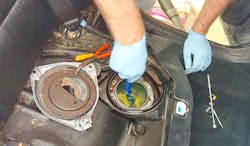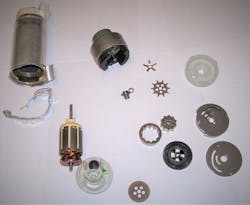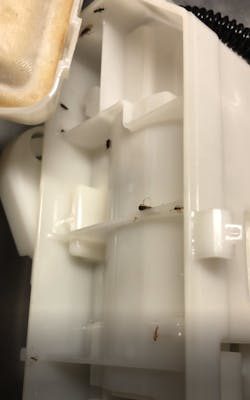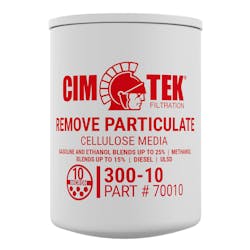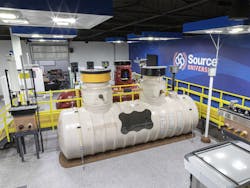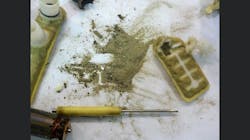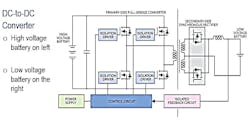Content brought to you by Motor Age. To subscribe, click here.
What you will learn:
• Fuel pumps usually fail for an underlying reason
• Determining the root cause of the failure prevents comebacks
• Failure causes both lack of pumping ability and/or electrical faults
Let’s be honest. We’ve all faced doing a dirty job to fix a problem that we either denied existed or spent too much time complaining about. Usually, the last advice we ever want to hear is “deal with it!”
At the risk of some Motor Age readers flipping to the next article with that kind of intro, I’d like to address an age-old problem that you might think either doesn’t exist today or isn’t very common, “fuel system contamination.” More importantly, I’ll offer practical suggestions to help you deal with it. To keep this simple and brief, I’ll focus on gasoline fuel system contamination from the aspects of the denial and aftermath, the sources, and the ways to “deal with it."
Trouble-free fuel systems?
As a young technician in the 1980s focused on driveability and electrical diagnostics, I saw plenty of fuel system contamination. I quickly learned that carburetors have never been trouble-free and that the age-old problem of contaminated gas tanks, combined with the new problems associated with computer-controlled emissions systems, made vehicles even less trouble-free.
Then came fuel injection, (no more troublesome bowl floats, needles/seats, and plugged jets), followed by plastic fuel tanks (no more rust), and finally the returnless fuel systems (no more fuel filters to change). Life in the bay working on fuel systems should be easy now, right? Replace a few fuel injectors and maybe an occasional GDI high-pressure pump. Modern fuel systems have finally been perfected (Not!). Modern returnless fuel systems (even in GDI-equipped vehicles) But we still have problems because of fuel system contamination!
Contamination . . . denial and aftermath
Let’s talk about the denial aspect of contaminated fuel systems. “I rarely see contaminated gas tanks.” (Figure 1) I’ve heard that statement from lots of technicians in training classes and on hotline calls I’ve been involved with, but the contamination aftermath is a reality. How can I prove that? Have you ever dissected (torn down) a modular (in-tank) fuel pump assembly that failed for reasons other than high mileage or old age to try to figure out what made it fail so soon? My engineer friends call this “failure analysis” and have performed many thousands of them. I like to call it a fuel pump “autopsy” and have personally performed several dozen. My engineer friends told me that most fuel pump failures are due to contamination. I’m a typical auto tech, so I’m skeptical of anything an engineer tells me. “You guys just need to make better fuel pumps – deal with it!” Then I did a few fuel pump “autopsies” and had to agree they were onto something (Figure 2).
Forms of fuel system contamination
1. Environmental (dirt and water)
Sand, dust, and dried leaf particles tend to be present in every driving scenario, ranging from the obvious (unpaved roads and off-road driving) to the less obvious examples on paved roads. Ever looked at all the dirt and debris along roads, highways, and bridges? It’s getting worse as roads decay from lack of maintenance, and the old-fashioned street sweepers are rarely seen these days. The vacuum of vehicles racing down the road at highway speeds pulls the dirt, sand, and grime into the air. If it wasn't prevalent, we wouldn’t need an air filter for the engine!
Next is water. Fuel tank condensation is a reality. Anywhere there is air, there is humidity and condensation. Rainwater is another environmental contamination source. Rain entering your push lawn mower gas tank when left outside with the gas cap off is an easy mental image, but what about modern vehicles with “fairly” sealed-up fuel tanks? Don't rule out rainwater for older vehicles with rusted-out filler necks, missing gas caps, damaged capless filler neck flappers, and, as I’ll cover in the section on sources of contamination below, evap canister vent locations.
2. Wrong fuel/bad fuel
This is a category we’ve all seen on numerous occasions. Classic examples are gasoline added to a diesel vehicle (and vice versa), E-85 in a non-flex fuel vehicle, and stale fuel (turned to varnish). Incidents of E-85 put into the non-flex fuel vehicles are not as bad as they used to be thanks to regular octane fuel prices being within a few cents of E-85 in locations where it is available (Figure 3). Besides the notable lack of energy (compared to E-10), the gas can result in everything from no starts to lean codes, and damage to elastomers (discussed below). Testing for alcohol is simple using a graduated cylinder, a fuel sample, and some water.
3. Additives
Since the banning of leaded fuel in 1996, we've not had to worry much about the lead in gasoline wreaking havoc by coating O2 sensors and plugging catalytic converters. But you might be surprised to learn that if your customer's vehicle still has a metal fuel tank, adding excessive amounts of fuel system cleaner, octane boosters, fuel storage stabilizers, and gas line antifreeze can, over longer periods, wreak similar havoc. Metal tanks (there are a few still out there) use a special plating (terne plating) to keep the welded seams from rusting.
Prolonged use of additives or E85 (both containing alcohol) can emulsify (dissolve) the terne plating. The plating is a tin-lead alloy, so now lead is in your fuel system. Elastomers (rubber seals & O-rings) throughout the fuel system will also begin to emulsify from E-85 (unless the rubber is rated for it) and excessive concentration of other liquid additives. Fuel leaks and evap DTCs can be the result.
Sources of fuel system contamination
1. Evap canister failures and evap vents
If you ever worked on vehicles with carburetors and evaporative emissions canisters, you may recall seeing evap canister failures that resulted in having to rebuild a carburetor (due to charcoal contamination). The canister (due to flooding from the carburetor or an overfilled gas tank) would fail in a manner that caused the activated charcoal granules to break up and enter the carburetor through the bowl vent. Fast forward to 2022; no carbs to worry about finding charcoal in, but we do see it in the evap purge solenoids and occasionally the fuel tank. What about evap vents? The mud daubers, bugs, (Figure 4), and spiders that nested (and rainwater that flowed) into the evap vent filters on GM pickup trucks a few years ago resulted in a TSB. It instructed techs to relocate the evap vent and associated hose to prevent future evap-related problems.
Another evap-related TSB from Nissan comes to mind. The TSB says to remove the evap canister from a suspect vehicle and place it on a postage scale, then compare its weight to a new/known-good evap canister of the same part number. If the one on the vehicle is heavier (by a specified amount) than the new/known-good part, and there are no signs of liquid gasoline dripping out of the canister (gas could also make it weigh more) the conclusion is excessive contamination (dirt) in the canister. The fix is to replace it.
Typically, unless you smell raw fuel, evap problems manifest as MILs with DTCs or problems in filling the tank at the gas station. If the evap system has restrictions on the vent side, the air internal to the fuel tank won't be able to escape into the canister (where vapors are adsorbed by the activated charcoal) and then on out to the atmosphere via the canister vent/filter. My conclusion is this; if all this dirt is a common problem with evap canisters and evap vent filters, wouldn't it stand to reason that at least "some" of this dirt is getting into the gas tank?
Gas tanks are like people; they breathe. They exhale with a full tank of cool fuel after a gas station fill. As the cool fuel begins to warm in the tank of a vehicle parked on a hot parking lot (summer day), it will expand and create vapors. Where do they go? Into the evap system to be absorbed. When does the gas tank inhale? When your customer drives the vehicle on longer trips. As the fuel level drops, there must be a means to allow fresh air to take up the unused space in the tank once occupied by fuel. If there wasn't a vent to the gas tank, it would "oil can" (collapse) as the fuel level went down.
Part of the vent system is the evap vent/filter (remember that source of dirt?), but if negative pressures (vacuum) build beyond the ability for the tank to keep its shape, (as with a plugged evap vent) the fuel cap/capless filler neck flapper valve is designed to perform vent duties as a backup to prevent tank deformation. That means the area around the filler neck (Figure 5) is a potential source for contamination, not only when you fill the tank at the gas station (and expose the tank to dirt) but when you drive!
2. The fuel supplier
The advice we give every customer on not getting gas when the tanker truck is refueling the underground tanks has been debunked as misinformation, like about everything else (true or false) these days. The argument has always been that the tanker “dumping fuel” into the station’s underground tanks is stirring up the water and sediment that lurks at the bottom of every tank. So don’t fuel your vehicle at that station.
The truth is, it depends on the design of the underground tanks, the maintenance of the gas pump's filter, and several other factors. Modern high-volume fuel retailers usually have their act together when it comes to gasoline underground storage tanks (UST) and contamination (Figures 6 + 7). I’ve emphasized “usually” for a reason, as unforeseen things happen. High volume can lead to low volume during pandemics and economic downtimes. Retailers can be put on C.O.D. until their account with their wholesaler is paid. That means they're more likely to be "running on empty" from the bottom of their USTs. The same applies to your fleet customers who have their own fuel USTs.
Case Study:
I stopped by an auto part store a couple of years ago to buy a part for my personal vehicle. The counterperson recognized me and said, “We’ve had mostly good luck with your company’s line of fuel pumps, but we had a string of defective pumps. It was four in a row, on the same vehicle. The shop finally put in a ______ brand fuel pump and the vehicle seems to be fixed now.”
I can never resist helping another tech solve a mystery on a vehicle with repeat problems. So, I asked the counterperson if I could have one of the warrantied fuel pumps, have the part number of the other brand that "fixed the vehicle," and get any other clues to help figure out what went wrong. I found out the pump that finally “fixed the vehicle" was indeed another brand (but we made that part as well). We made it to the exact same specs as the four that failed! Did the brand name on the box make a difference? No. I also found out that the shop’s customer (that the four pumps went into) was a pickup truck with huge tires and a lift kit. Did that make a difference? No.
The fuel pump I was handed (replacement number three) was covered with dirt on the top of the unit. Did that make a difference? No. I took the pump home and did a teardown (autopsy) of the modular fuel pump. Not only was the exterior of the pump dirty, but the modular reservoir (bucket) also had a large amount of dirt/sediment inside. I went further with the “autopsy” and found the internal strainer was full of dirt and there was plenty of debris in the pump's turbines as well (Figure 8) ... Case closed.
The shop didn't fix its customer’s truck with a brand X over brand Y (they were the same); the shop fixed the truck by cleaning the tank via four non-serviceable (lifetime) filters in the four replacement fuel pumps. That’s one expensive way to clean a contaminated gas tank!
The shop called the customer, who admitted to doing a lot of off-roading, including some mudding. Is there a fuel pump that will withstand that? It would be better to look at moving/modifying the evap vent filter to make it serviceable! Then I recalled my youthful wrenching days when Hobbs Auto Electric tune-ups on every GM vehicle included an inexpensive "powder puff" charcoal canister vent filter – to keep dirt out of evap canisters (and fuel tanks).
No visible presence of contamination inside the tank?
Sometimes the tank has no signs of contamination in it. Even if you drain it and run an inspection scope to look at every nook and cranny, there may not be any visible contamination. The contamination may be located inside the fuel pump assembly. How does this happen?
In some applications, the fuel may be drawn (including dirt) very efficiently into the pump, where the contamination will stay. With a normal amount of dirt over a normal lifespan of a pump’s internal filter, there should be no problems. But with an above-average amount of “garbage” into the tank, the pump's internal filtering may fill up and create a problem for the pump. If the strainer/screen before the pump restricts, pressure and/or fuel volume may drop, and the pump motor may cavitate and manifest as a driveability problem. Do this long enough, and the pump could die an early death from overheating. Fuel is what cools the pump.
If the filtering media after the pump (but still internal to the assembly) fills up/restricts, the same pressure/volume/driveability symptoms may occur, but the pump could overheat from higher than normal current (amps) over the long haul. Without an external inline fuel filter (frame rail mounted filter from old-school return line system technology), all filtering is done inside the fuel pump assembly. Look up the flow rate of a modern in-tank fuel pump. Whether it’s a 12-year-old pick-up truck with SFI or a newer passenger car with GDI, the modular (electric) fuel pump that pushes the fuel from the tank to the engine compartment has a flow rate spec somewhere between 25-35 gph (gallons per hour), depending on the exact application. Generally speaking, the entire contents of a fuel tank move through the fuel pump (and its internal screens/filtering media) at least once every hour!
Conclusion
If you do see dirt, rust, or other contamination in a fuel tank when you’re ready to replace a fuel pump, drain and remove the fuel tank to perform a complete cleaning of the tank. If you can't figure out how to get paid for all that work, or the fuel pump R&R can be done w/o pulling the tank, at least use a fuel tank cleaning wand that has scrubbing pads with magnets to pick up any ferrous debris from the bottom of the tank. In either case, always do as deep of a fuel pump autopsy as (time and warranty return part rules allow) to try to determine what killed the pump. The last thing you want to do is continue throwing parts at the vehicle/be in denial about the number one enemy of fuel systems – contamination!
Until street sweepers make a comeback and customers agree to only drive on paved roads, environmental (dirt) fuel system contamination will be the natural enemy to fuel pumps and evap systems. Cleaning fuel tanks (when applicable) will definitely help. A new (serviceable) aftermarket evap filter solution would be another idea. Until that comes along, we'll need to continue with the "dirty job" of dealing with fuel system contamination!
